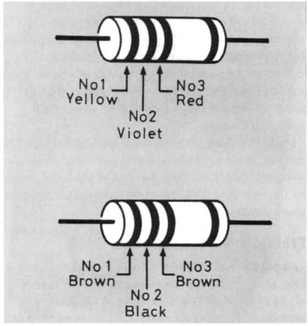What is a resistor?
Resistors
If there wasn’t such a thing as resistance, the subject of electronics wouldn’t exist; only infinite currents would flow and voltages wouldn’t exist either! We need to reduce the flow of current if we are to make current do something useful for us. Components that resist the flow of current arc called resistors, and they are said to have a resistance which is measured in ohms (Ω), named after Georg Ohm, who formulated the law (also named after him) by which the voltage and current through a conductor are related, His law gave rise to the formula everyone remembers:
From this equation, you can see that, for a constant value of voltage, V, if the resistance goes up, the current will go down, and vice versa. The circuit symbols for resistors are shown in Figure 1. You will find the upper symbol in older magazines; it is still preferred by many engineers. The lower symbol is the prevalent standard symbol.
Resistors are made in several ways, the cheapest using carbon; another type is usually made from a ceramic cylinder (used only as a support) on which is placed a very thin film of metal – the thinner the film, the greater the resistance. All resistors are coated with a thin film of insulation, for the same reason we discussed earlier.
The colour code
Each resistor has coloured bands on it which enable us to see what value of resistance it has. There are normally three (but sometimes four) at one end, and a single one at the other (see Figure 2). The colours indicate figures, according to the list below.

Using the colour codes is easy, once you see the logic behind it. Hold the resistor so that the single band is towards the right. The three colours on the left are read in the normal order from left to right. The first two bands always indicate numbers; the third band gives the number of zeros to add to the right of these two numbers. So, looking at the top resistor in Figure 2, yellow, violet, red means 4, 7, and two zeros, giving 4700 ohms! Looking at the lower resistor, brown, black, brown means 1, 0, and one zero, giving 100 ohms.
Remembering the order of the colours may be difficult at first. The colours from red to violet are the colours of the rainbow, in order, so if you know those, you’re almost there! Around those colours are black and brown below the red, and grey and white above the violet, which you can imagine as getting brighter from black to white (well, almost!). It won’t be long before you don’t need to remember them at all.
The isolated band on the right-hand side is not part of the resistor’s value; it indicates its tolerance, i.e. how close it might be to the indicated value. A brown band indicates ±1 %, a red band ±2%, a gold band ±5% and a silver band ±10%. For example, a resistor marked as being 100 ohms with a ±5% tolerance will have an actual value somewhere between 95 ohms and 105 ohms.


